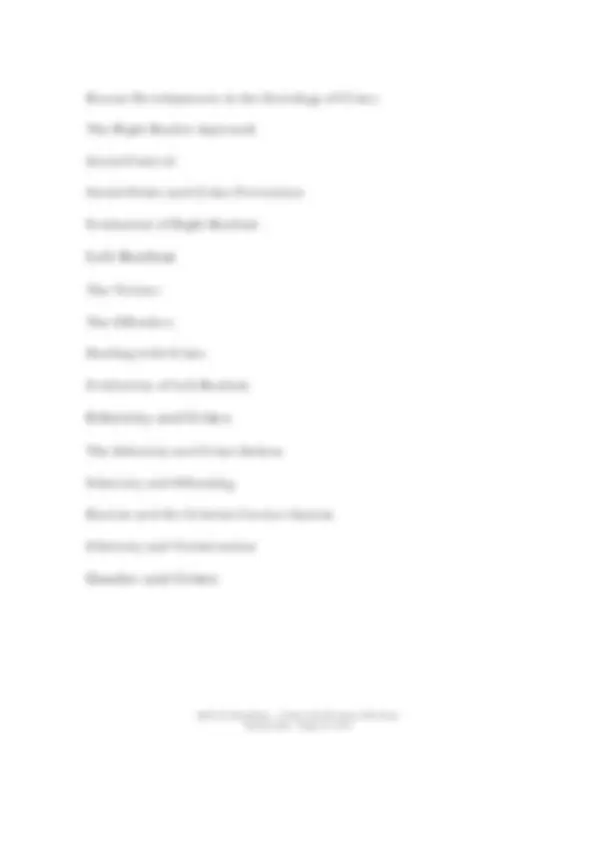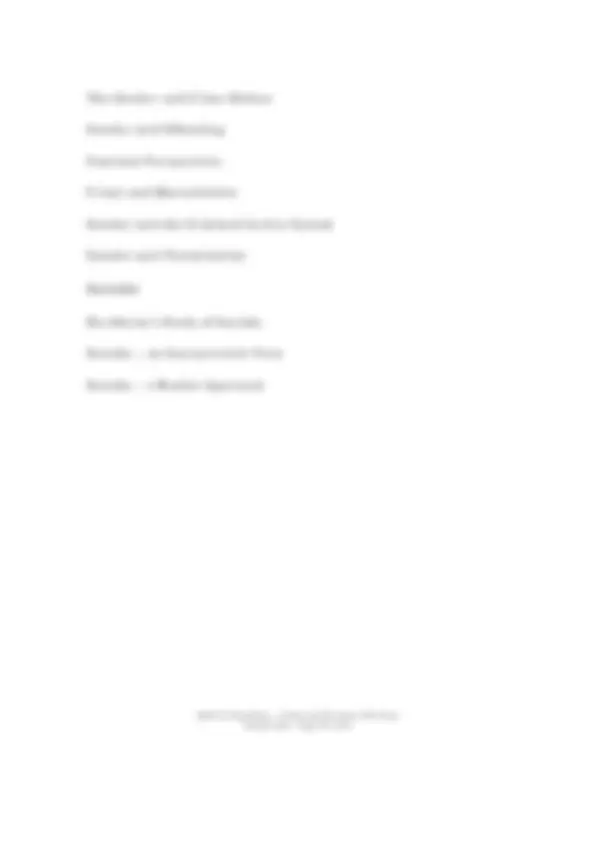Download A2 AQA Sociology – Crime and Deviance and more Schemes and Mind Maps Sociology in PDF only on Docsity!
AQA A2 Sociology – Crime and Deviance Revision
- A2 AQA Sociology – Crime and Deviance.......................................................................... A2 AQA Sociology – Crime and Deviance
- The Nature of Crime, Deviance and Social Control.................................................................................
- Defining Crime and Deviance ..............................................................................................................
- Contexts and Diversity of Deviance .....................................................................................................
- The Relativity of Crime and Deviance..................................................................................................
- Social Control .......................................................................................................................................
- Crime Statistics........................................................................................................................................
- The Volume of Crime ...........................................................................................................................
- Trends in Crime ...................................................................................................................................
- The British Crime Survey (BCS)...........................................................................................................
- Social Characteristics of Offenders ......................................................................................................
- Self-report studies ................................................................................................................................
- Media Representations of Crime
- Media Images of Crime
- Pattern of Crime News .........................................................................................................................
- Explaining Media Representations of Crime .......................................................................................
- The Media and Perceptions of Crime ...................................................................................................
- Explaining Crime and Deviance: Functionalism, Strain Theory and Subcultural Theory ......................
- Normalising the Criminal ....................................................................................................................
- Functionalism and Crime...................................................................................................................
- Strain Theory (Robert K. Merton)
- Subcultural Theory..............................................................................................................................
- Delinquency and Drift........................................................................................................................
- White-Collar Crime
- Interactionism and Labelling Theory
- The Interactionist Approach
- Labelling Theory
- Deviancy Amplification
- Marxism and Radical Criminology AQA A2 Sociology – Crime and Deviance Revision
- Traditional Marxist Approaches
- Radical Criminology...........................................................................................................................
- Right Realism and Social Control..........................................................................................................
- Recent Developments in the Sociology of Crime
- The Right Realist Approach
- Social Control
- Social Order and Crime Prevention
- Evaluation of Right Realism
- Left Realism
- The Victims
- The Offenders.....................................................................................................................................
- Dealing with Crime
- Evaluation of Left Realism
- Ethnicity and Crime...............................................................................................................................
- The Ethnicity and Crime Debate
- Ethnicity and Offending
- Racism and the Criminal Justice System
- Ethnicity and Victimisation
- Gender and Crime..................................................................................................................................
- The Gender and Crime Debate
- Gender and Offending
- Feminist Perspectives
- Crime and Masculinities
- Gender and the Criminal Justice System
- Gender and Victimisation
- Suicide
- Durkheim’s Study of Suicide
- Suicide – an Interpretivist View
- Suicide – a Realist Approach
AQA A2 Sociology – Crime and Deviance Revision
Link from Power and Politics Unit: Althusser (1971) a Marxist, made the distinction between repressive and ideological state apparatus. He saw the police and judiciary as repressive state apparatus which maintained the position of the ruling class; whereas, he saw ideological state apparatus (education, religion and media) as legitimising the position of the bourgeoisie.
Crime Statistics
Two main crime surveys –
- policed recorded crime – based on police records
- British Crime Survey (BCS) – based on interviews with a representative sample of adults.
The Volume of Crime
2002/3 – 6,468,000 cases of record crime in the UK (Social Trends, 2004) These statistics do not represent the total volume of crime. There is a so called “dark” or “hidden” figure of unrecorded crime. Over 30% of offences reported to the police in 2002/3 were not recorded (Simmons and Dodd, 2003) Reporting (and non-reporting) of Crime – over 80% of all recorded crimes result from reports by the public (Bottomley and Coleman, 1981). Some types of crime are more likely to be reported than others. For example, 97% of vehicle thefts were reported to the police in 2002/3. This compares with estimates which suggest that only a third of incidents of vandalism and theft from the person are reported (Social Trends, 2004) There are many reasons why crimes are not reported to police:
- lack of awareness that a crime has taken place (i.e. fraud)
- victim is powerless or frightened (i.e. child abuse, domestic violence)
- the offence seems to trivial (i.e. vandalism)
- there is no apparent victim (i.e. prostitution)
- the view that the police will not act on a report
- the matter is dealt with privately Crime statistics rely heavily on the public incidents to the police. Since some crimes are more likely to be reported than others, official statistics will not reflect an overall pattern of crime. Holdaway (1988) – “Official statistics of crime are not so much the facts about crime, as the end product of a complex series of decisions”
AQA A2 Sociology – Crime and Deviance Revision
Trends in Crime
Since the mid-1990s the proportion of crime reported to police has remained more or less the same at 44% of all crime , much higher than in the early 1980s (Simmons and Dodd, 2003). A number of reasons have been suggested for this:
- Increased telephone (and mobile phone) ownership
- Growth of reported burglary between 1981 and 1993 may be related to an increase in valuable goods in the home (TVs, videos etc.). More insurance policies now cover house contents and insurance companies require a police report when a crime has been committed (Mayhew et al., 1994)
- People are less willing to tolerate certain types of crime. For example, violent crime – recorded incidents of robbery, rape and theft from the person more than doubled between 1991 and 2000/01 (Maguire, 2002)
- Break-up of close knit-communities may result in people being more inclined to bring in the police to deal with incidents rather than sorting things out themselves (Maguire, 2002)
The British Crime Survey (BCS)
The British Crime survey is a victim study , based on a representative sample of adults living in private households in England and Wales – 75% response rate 2002/. Some offences are excluded:
- Murder
- ‘Victimless crimes’ (drug possession or dealing)
- Fraud
- Offences against non-domestic targets such as businesses
- Sexual offences Only 29% of all BCS crimes were actually recorded by the police and entered the official statistics of police recorded crime (Simmons and Dodd, 2003) Trends – from 1981 to 1995, BCS estimates show a steady rise in crime. Since then there has been a steady fall – by 2002/03, the estimates were only slightly above the 1983 level. Evaluation – for the crime it covers, the BCS provides a more accurate picture of the extent of crime and of trends in crime than police recorded crime, for two main reasons:
- BCS estimates include unreported and unrecorded crime
- Trends identified are not affected by changes in recording practices, unlike the trends from police records.
AQA A2 Sociology – Crime and Deviance Revision
- physically struck someone intentionally It is possible to argue that crime is ‘normal’. If this is the case then there is not particularly distinctive about the social characteristics of those who break the law. Many crimes can seem pretty trivial and how many crimes do people commit? Self report studies indicate that committing one or two criminal acts is a ‘normal’ part of growing up for most boys. However, frequent law breaking is relatively rare (Hood and Sparks, 1970). Gender – reflect official statistics, more men commit crimes than women Social Class – the lower a person’s social class, the more likely they are to commit a crime; this reflects the picture given in official statistics (Coleman and Moynihan, 1996). Age – crime ‘is a younger person’s game’. However, young people are more likely offend in public and in groups so they are more visible and more like to be apprehended. Self report studies traditionally have focused on crime committed by young working-class males, particularly street crime. They tend to omit ‘hidden crimes’ and adult crimes such as domestic violence. They are unlikely to include fraud, often committed by middle-class, middle-aged men. Therefore, self-report studies only give a partial view of crime.
Media Representations of Crime
Media Images of Crime
A study comparing the top ten national daily newspapers looked at the proportion of space given to crime. In 1989, 12.7% of events reported were about crime. The proportion of space given was greater the more down-market the paper: The Guardian – 5.1% The Sun – 30.4 % Williams and Dickinson, 1993 Another study found broadcast news devoted even more time to crime than the press, with commercial stations containing a higher proportion of crime features than the BBC (Cumberbatch et al., 1995). Studies indicate that the proportion of news devoted to crime has increased over the last 50 years. Daily Mirror and The Times 1945 – 8% Crime Daily Mirror and The Times 1991 – 21% Crime Reiner at al., 2000
AQA A2 Sociology – Crime and Deviance Revision
Pattern of Crime News
The coverage of violent and sexual crimes is significantly greater than the incidence in all statistics. Homicide accounts for one-third of all crime news. Williams and Dickinson (1993) study of ten national newspapers in 1989 found that 64.5% of crime stories dealt with violence against the person. According to BCS, only 6% of crimes reported by victims in 1989 were violent. The media usually presents a positive picture of the criminal justice system. There are stories exposing police corruption and malpractice but they tend to focus on the failings of the individual rather than the criminal justice system as a whole (Chibnall, 1977). When the system is clearly to blame, the media usually report that reforms have been made. Again, the legitimacy of the criminal justice system is safeguarded. Link from Power and Politics Unit Miliband (1969) believes the elites in the government, judiciary and business are related by marriage and kinship and work together to maintain the capitalist system. Crime and Reality TV- has blurred the boundaries of news and fiction. For example, Crimewatch UK, focuses on murder, armed robbery with violence and sexual crimes (Dobash et al., 1998) much like the news. Crime Fiction – staple ingredient of media fiction:
- between ¼ and 1/3 of paperback novels could be categorised as crime (Mandel, 1984)
- Since 1945, 20% of films crime movies and 50% have significant crime content (Allen et al., 1997)
- Since 1955, some 25% of the most popular British TV programmes have been crime or police series (Reiner et. al., 2000)
Explaining Media Representations of Crime
News values, journalists are taught what makes a good new story:
- Novelty, freshness, and surprise
- Drama and excitement
- Titillation
- A focus on personalities (Chibnall, 1977) It is therefore no surprise that the news concentrates on violent and sexual crimes. Sources of Crime News – the police and courts are the main source of crime news. Journalists are therefore largely dependent on official sources for their information. These sources have become primary definers – they define what counts as crime, what counts as justice , and what crimes
AQA A2 Sociology – Crime and Deviance Revision
Functionalism and Crime
Functionalists view crime and deviance beyond a certain level, to be dysfunctional. However, Durkheim (1964) views crime and deviance to a certain level to be ‘normal’ and also “an integral part of all healthy societies” Davis (1961) argues that crime and deviance act as a ‘safety valve’ – there is conflict between man’s instinctual need for sexual satisfaction and society’s need to restrict the legitimate expression of sex to within the family. Clinard (1974) – saw crime and deviance as a ‘warning function’ that signals a defect in the social organisation which may lead to changes “that enhance efficiency and morale”.
Strain Theory (Robert K. Merton)
American culture attaches great importance to success – success is measured in terms of money and material possessions. There are norms which define legitimate means for achieving success. These legitimate means include gaining skills and qualifications and career advancement. The American Dream states that anybody can make it to the top if they try hard enough. Anomie (normlessness) – so much emphasis is placed on material possessions that many people experience pressure to deviate from accepted norms and values. Deviance occurs when they reject the goal of success and/or the legitimate means of reaching that goal. Social Structure – Despite what the American Dream says, not everybody has an equal chance of success. The social structure prevents equal opportunity. The strain to anomie is most strongly felt by those at the bottom of the class structure. Adaptations – Merton identifies five possible adaptations or responses to the strain to anomie in American society:
- Conformity - aim for success, follow rules
- Innovation – aim for success, reject rules
- Ritualism – reject furthering success, but follow rules
- Retreatism – reject goal, reject rules
- Rebellion – replace goals, replace rules with own norms Evaluation of Strain Theory – strain theory is an early attempt to explain crime and deviance sociologically, offering an explanation of working class crime. However, it does not answer some questions: Why do some people, but not others adopt deviant adaptations? Strain theory focuses on individuals rather than groups, crime and deviance are often collective activities
AQA A2 Sociology – Crime and Deviance Revision
Crime and deviance is not always motivated by a desire for monetary gain. How can activities such as vandalism and fighting between rival groups be explained with Merton’s strain theory?
Subcultural Theory
Cohen (1955) – examined delinquent gangs in low-income, inner-city areas. Cohen agreed with Merton that the mainstream value of success creates problems for young working class males. Many do badly at school and fail to acquire the skills and qualifications needed for success. Status Frustration – defined as failures by the wider society many-class class adolescents experience status frustration. Subcultural Solution – faced by a common problem of adjustment, a problem they share, some working class adolescents develop a deviant solution. They create their own subculture with their pwn norms and values which differ from those of mainstream society. This is where collective deviance activities come in – gang members require an audience to gain respect. The ‘successful’ delinquents gain status in the eyes of their peers and subculture. Non-utilitarian crime – if status frustration is the main problem, then criminal activity to achieve monetary may not be necessary. Vandalism, joy-riding, fighting, anti-social behaviour can bring respect from their subculture’s members as well as fighting against the society that has rejected them. Cloward and Ohlin (1961) – Opportunity Structures Cloward and Ohlin argue that both Merton and Cohen fail to explain why delinquent subcultures take different forms – why some focus on violence and others theft. They believe different social environments provide different opportunities for crime and deviance, which in turn, encourage the development of different delinquent subcultures: The Criminal Subculture – develop in areas where there is a well-established pattern of adult crime. The Conflict Subculture – areas of illegitimate opportunity structure and high population turnover and low social cohesion. Little opportunity for established criminal groups so groups turn to violence. The Retreatist Subculture – emerges among those who have failed to succeed either by legitimate means or as members of a criminal or conflict subculture. Sometimes these ‘failures’ form retreatist subcultures based on illegal drug use. Evaluation – Cloward and Ohlin tend to box off the subcultures and do not acknowledge overlaps. For example, gangs can be involved violence but still make money from dealing drugs. Also people in retreatist subcultures can also successfully deal drugs as well (Winlow, 2001)
AQA A2 Sociology – Crime and Deviance Revision
Recent Developments in the Sociology of Crime
The Right Realist Approach
Social Control
Social Order and Crime Prevention
Evaluation of Right Realism
Left Realism
The Victims
The Offenders
Dealing with Crime
Evaluation of Left Realism
Ethnicity and Crime
The Ethnicity and Crime Debate
Ethnicity and Offending
Racism and the Criminal Justice System
Ethnicity and Victimisation
Gender and Crime
AQA A2 Sociology – Crime and Deviance Revision
The Gender and Crime Debate
Gender and Offending
Feminist Perspectives
Crime and Masculinities
Gender and the Criminal Justice System
Gender and Victimisation
Suicide
Durkheim’s Study of Suicide
Suicide – an Interpretivist View
Suicide – a Realist Approach
























